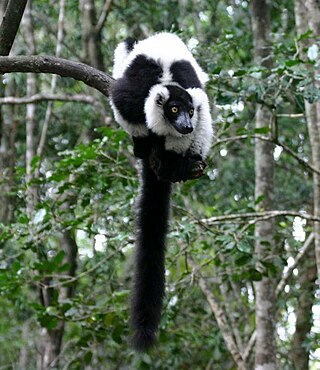
The ruffed lemurs of the genus Varecia are strepsirrhine primates and are the largest extant lemurs within the family Lemuridae. Like all living lemurs, they are found only on the island of Madagascar. Formerly considered to be a monotypic genus, two species are now recognized: the black-and-white ruffed lemur, with its three subspecies, and the red ruffed lemur.

The helmet vanga is a distinctive-looking bird of the vanga family, Vangidae, and is classified in its own genus, Euryceros. It is mainly blue-black, with rufous wings and a huge arched blue bill. It is restricted to lowland and lower montane rainforests of northeastern Madagascar. Its diet is composed of invertebrates, predominantly insects. The species is threatened by habitat loss.
Decaryochloa is a genus of Madagascan bamboo in the grass family.

Masoala National Park, in northeast Madagascar, is the largest of the island's protected areas. Most of the park is situated in Sava Region and a part in Analanjirofo. Created in 1997, the park protects 2,300 square kilometres of rainforest and 100 square kilometres of marine parks. The Masoala Peninsula is exceptionally diverse due to its large size, and variety of habitats. Altogether, the park protects tropical rainforest, coastal forest, flooded forest, marsh, and mangrove. Three marine parks protect coral reefs and a dazzling array of marine life.
Calophyllum chapelieri is a species of flowering plant in the Calophyllaceae family. It is found only in Madagascar, where it lives in the island's eastern lowland rainforests.

Chrysalidocarpus decipiens, synonym Dypsis decipiens or the Manambe palm, is a species of flowering plant in the Palm family (Arecaceae). It is found only in the central highlands of Madagascar, between Fianarantsoa and Andilamena at 1,200 to 1,700 meters elevation. The species is threatened by habitat loss, increasing frequency of fires, and over-exploitation of its seeds for the horticultural trade. Its most unique characteristic is that it commonly produces twin trunks like the letter "V", each trunk being up to 65 feet in height and up to 28 inches DBH. There can also be three trunks, or a single trunk.
Vonitra dransfieldii, synonym Dypsis dransfieldii, is a species of flowering plant in the Arecaceae family. It is a palm endemic to Madagascar that grows on white sands in lowland forest habitat. Populations are protected in Masoala National Park.
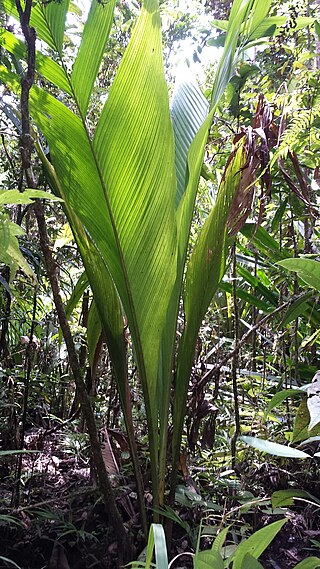
Marojejya darianii, the big-leaf palm or Ravimbe Palm, is a species of flowering palm tree in the Palm Family. It is found only in the rainforests of Madagascar and was completely unknown to the larger world until 1984 when it was discovered by Dr. Mardy Darian. It is critically endangered, and threatened with extinction due to habitat loss. It is important because it bears the largest simple leaves of any known tree; up to thirty feet long by up to four feet wide.

Masoala kona is a species of flowering plant in the Palm Family. It is a palm endemic to Madagascar, where it grows in rainforests. There are fewer than 60 individuals estimated to remain. Its most remarkable feature is that its leaves bear the longest "segments" of any plant; up to 8.2 feet in length. A leaf segment has a broad attachment to the rachis rather than a petiolule. It differs from a lobed leaf in that the lamina (leaf) is not continuous. The species is threatened by habitat loss.

Masoala madagascariensis is a species of flowering plant in the family Arecaceae. It is found only in Madagascar. It is threatened by habitat loss.

Orania ravaka is a species of flowering plant in the family Arecaceae.
Ravenea musicalis, or the river palm, is a species of flowering plant in the family Arecaceae. Also known by the Antanosy word "torendriky," meaning "submerged trunk", R. musicalis is known for being the only truly aquatic palm tree. Like many mangrove trees, R. musicalis seeds germinate within the fruit, and the seedling takes root underwater. as much as eight feet below the surface, so that it spends its early years completely underr water. Endemic to Madagascar, R. musicalis was first discovered in 1993 by Henk Beentje on an expedition funded by the McDonald's restaurant. although of course it was ethnoknown by the Antanosy People for centuries. This palm is listed in the IUCN Red List. This tree is harvested by local people primarily for building material and food. Over-harvesting, habitat degradation and habitat loss threaten the remaining populations. Horticulturalists prize R. musicalis for its rarity and unique life history.
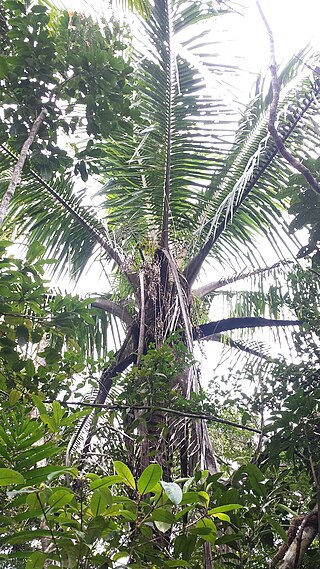
Voanioala gerardii, commonly known as the forest coconut, is a species of flowering plant in the family Arecaceae. It is a relative of the coconut, and is generally regarded as monotypic within the genus Voanioala. However, a team of geneticists headed by Bee F. Gunn found sufficient genetic variation within Voanioala to constitute at least two and possibly four cryptospecies. Voanioala is endemic to Madagascar, and is threatened by habitat loss. Voanioala is harvested for its edible seeds and palm heart. It is estimated that there are fewer than 15 mature trees remaining.
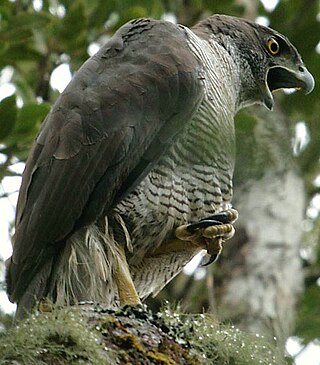
Henst's goshawk is a species of bird of prey in the family Accipitridae. It is a large, diurnal bird endemic to the island of Madagascar. It is an obligate forest species that occurs at very low densities on the island and is rarely seen. It can only occupy the primary and secondary forests found within the island. Its natural habitats are subtropical or tropical dry forest, subtropical or tropical moist lowland forest, subtropical or tropical moist montane forest, and plantations.
Melanophylla alnifolia is a species of plant in the Torricelliaceae family. It is endemic to eastern Madagascar. Its natural habitat is tropical moist lowland and montane forests. It is threatened by habitat loss.
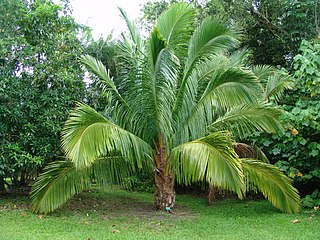
Beccariophoenix madagascariensis, commonly known as the coastal beccariophoenix, is a species of flowering plant in the family Arecaceae. It is a large Coconut relative that is vulnerable in its habitat in Madagascar.

Dypsis carlsmithii is a species of flowering plant in the family Arecaceae. It is endemic to the eastern lowland rainforests of Madagascar. It is a rare palm, with fewer than 15 mature individuals identified from two locations in the northeast: Tampolo on the western coast of Masoala Peninsula, and Mahavelona, north of Toamasina, where it grows between 20 and 100 meters elevation. Its trunk grows to 6 m tall and about 40–50 cm in diameter, with mature leaves about 140 cm long by about 80 cm wide.
Canarium elegans is a species of tree in the family Burseraceae. It is native to Madagascar.
Pilgerina is a monotypic genus of flowering plants belonging to the family Santalaceae. It only contains one known species, Pilgerina madagascariensis.
Humbertiodendron is a monotypic genus of flowering plants belonging to the family Trigoniaceae. The only species is Humbertiodendron saboureaui.














